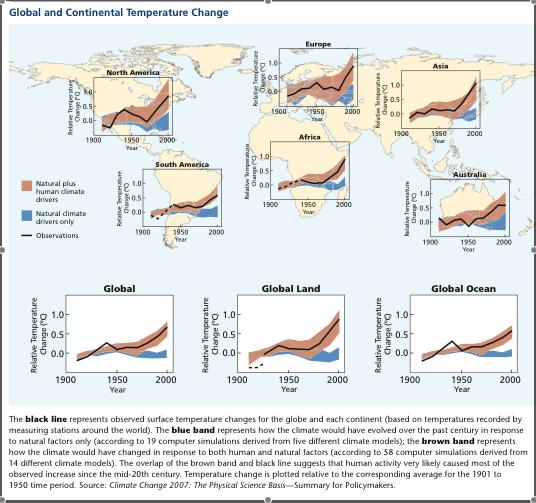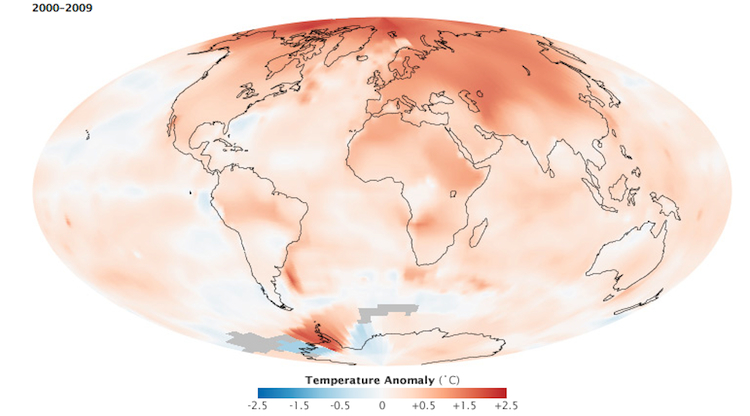Temperature Trends
 Figure 5.15 Geoscientist examines ice core used to study changes in
atmospheric
composition. (Courtesy:
National Ice Core Laboratory, NOAA)
Figure 5.15 Geoscientist examines ice core used to study changes in
atmospheric
composition. (Courtesy:
National Ice Core Laboratory, NOAA)
The fact that atmospheric gases
contribute to the heating of the Earth is not new. A hundred years ago,
Swedish scientist Svante Arrhenius ![]() became
the first person to investigate the effect that doubling
atmospheric carbon dioxide would have on global climate. Though all
atmospheric scientists agree that there is a greenhouse effect, not all
agree on the impact that human beings are having on it. In particular,
many cannot agree that the present global warming
that we are experiencing is a product of human activities. Analysis of
ice cores has shown a significant variation in the
carbon dioxide content of our atmosphere which has affected global air
temperatures since the great ice sheets marched across the continents.
Measurements
of greenhouse gas concentrations over the last 150 years have shown a
steady increase in carbon dioxide with an apparent increase in global
temperatures as a
result. Research has shown that there has been a 30% increase in the
carbon dioxide content since the dawn of the industrial age. This
increase is due to a number of activities such as fossil fuel burning,
deforestation, and loss of other carbon dioxide "sinks" like wetlands
and forests. The burning of fossil fuels releases stored carbon into
the atmosphere raising the carbon dioxide content of the air.
Forest removal leaves carbon dioxide in the air to enhance the natural
greenhouse effect.
became
the first person to investigate the effect that doubling
atmospheric carbon dioxide would have on global climate. Though all
atmospheric scientists agree that there is a greenhouse effect, not all
agree on the impact that human beings are having on it. In particular,
many cannot agree that the present global warming
that we are experiencing is a product of human activities. Analysis of
ice cores has shown a significant variation in the
carbon dioxide content of our atmosphere which has affected global air
temperatures since the great ice sheets marched across the continents.
Measurements
of greenhouse gas concentrations over the last 150 years have shown a
steady increase in carbon dioxide with an apparent increase in global
temperatures as a
result. Research has shown that there has been a 30% increase in the
carbon dioxide content since the dawn of the industrial age. This
increase is due to a number of activities such as fossil fuel burning,
deforestation, and loss of other carbon dioxide "sinks" like wetlands
and forests. The burning of fossil fuels releases stored carbon into
the atmosphere raising the carbon dioxide content of the air.
Forest removal leaves carbon dioxide in the air to enhance the natural
greenhouse effect.
Figure 5.16 Global mean temperature Anomalies relative to 1901 - 2000 temperature
Courtesy NCDC/NESDIS/NOAA
Increasing levels of greenhouse gases results in rising global air temperatures. Global mean surface temperatures have increased roughly 1.53°F (0.85ºC) from 1880 to 2012. The annual trend in average global air temperature through December 2012 is shown in Figure 5.16. The range of measurement uncertainty is indicated by the gray vertical bars. The temperature trends over the past 100-plus years in Figure 5.17 clearly indicate rising temperatures on all continents and over the oceans.

Figure 5.17 Global and Continental Temperature Change, 1900 - 2000. Data for the last hundred years already show clear trends in warming for the globe and continents. (Source)
The last decade, 2000-2009, ended on the second warmest year on record. The temperature anomaly map (Figure 5.18) shows the departure from "normal" for the reference period of 1951 through 1980. Very little of the earth showed cooling while most experienced warming. The greatest warming occurred in the Arctic, coinciding with changes in surface albedo as annual sea ice diminishes.

Figure 5.18 2000 - 2009 Temperature Anomaly.
Courtesy NOAA EOS (Source)
Video: "Global Warming 101"
Courtesy
of National Geographic
